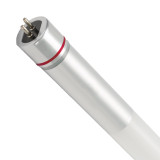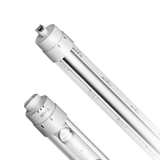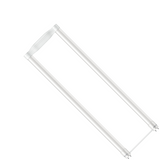LED Tubes - Fluorescent Replacement
LED Tube Lights
What is the size (diameter) of my tube light?
All fluorescent tube lights come with manufacturer stamps from which you can find the size of the tube. For example, an F32T8 and F54T5 is a T8 and T5 sized lamp, respectively. The tubular (T) sizing is done in 1/8ths of an inch making a T5 lamp a 5/8” in diameter tube. If the lamp is old and you cannot find a stamp or the existing stamp is not legible, then a good rule of thumb is a T5 is about the size of a dime and a T8 is about the size of a quarter.

LED replacements and retrofits for fluorescent tube lights follow for the most part this sizing scheme but due to the differences in technology the size of LED tubes are not exactly the same as fluorescents. LED tubes manufacturers use length and the connector (base) measurements as the most important metric when claiming equivalency. Due to this, T8 and T12 fluorescent lamps that share the same length and connection style but only different in diameter have one common LED replacement. Why make a wider T12-like bulb and spend more on materials when a skinnier T8-like bulb can fit in the same lamp holders?
One last important thing to consider, especially for T5 lamps, is that ballast bypass LED retrofits contain the transformer needed to power the LED chips internally inside the tube. This makes bypass (Type B) T5 LED’s thicker than the original T5 lamp to the point where it approaches T8 sizes.
What is the length of my fluorescent tube light?
Tube lights come in standard lengths for the most part such as 2 ft, 3 ft, and 4 ft. Typically, the longer the tube the more power it consumes (higher wattage rating). However, this is not always the case. Some specialty lights out there do exist that have the same wattage rating but differ drastically on the length or vice versa. The lighting industry standard measures bulbs to their ‘nominal’ length that is slightly longer than the bulb itself. This is for simplicity and because the summation of the lamp length and the width of the two lamp holders makes nears the nominal length. Always measure your bulb and check with the specifications or a sales associate to confirm if the LED tube will work in place of your fluorescent.
Operation Types – Ballast or No Ballast
Fluorescent lights are controlled by electronic and sometimes magnetic transformers called lighting ballasts. These ballasts regulate the incoming electricity to power the light. Due to their ubiquitous presence in lighting fixtures, lighting manufacturers wished to make conversion to LED tube lights as seamless as possible. Thus, LED tubes come in four types of operation modes to give the customer the choice if they want to re-wire and remove existing ballasts or keep them.
UL Type A – Plug and Play
Type A lights are called plug and play because they are compatible with existing electronic fluorescent lighting ballasts. Turn off the power, remove the fluorescent tube, plug in the LED tube, and turn the power back on. It is the same as replacing a bad fluorescent with a new one! Just make sure the ballast inside the fixture is a model that is listed on the manufacturer’s ballast compatible list. If the ballast is not on the list the LED lamp might still work, however since it has not been tested and approved by the tube manufacturer, the warranty on the LED is voided.
UL Type B – Ballast Bypass
Type B lights work directly off line voltage – typically 120V to 277V – because they have an internal LED driver that performs the role of the ballast but without all the extra wires! With Type B lamps you will need to do some re-wiring of the fixture. With bypass lamps there is an additional layer of complexity involving the way the LED tube receives power. They could be single-ended or double-ending meaning they may or might not work with existing lamp holders. It is best to carefully read the product pages for LED tubes and to confirm with the hardware in your own fixture before making a purchase.
UL Type C – External Driver
Type C lights are like Type A lamps but instead of working with an external electronic fluorescent ballast to handle their power delivery they use an external LED driver. Type B lamps have this driver inside each tube whereas Type C lamps put it remotely.
UL Type AB – Dual Mode
Type AB lights are called hybrid or dual mode lamps because they work with work in either Type A or Type B operation modes. These hybrid lamps give you maximum flexibility for installation. If the existing ballast is good, then you can go plug and play. If the ballast is bad, you can re-wire the fixture and still use the same lamp.





